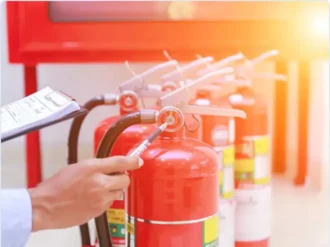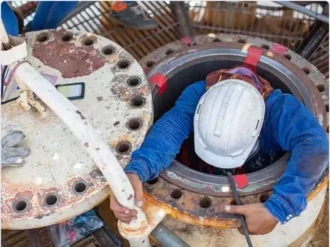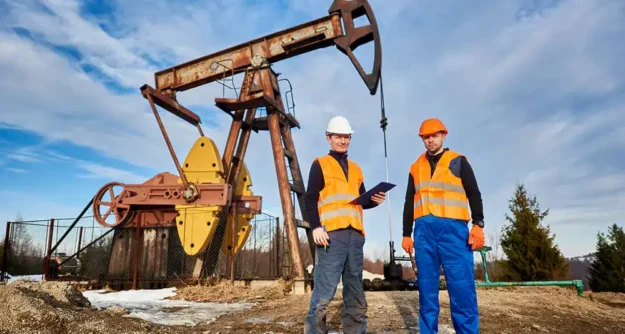Introduction
Oil extraction and recovery is an intrinsic part of the oil and gas industry, but the process exposes workers to considerable risks on a daily basis. From exposure to toxic gases and materials to working with dangerous vehicles, entering confined spaces, and handling highly flammable substances, the hazards associated with this sector demand that all employees receive rigorous training prior to working on-site.
Potential Hazards
The most common risks involved in oil extraction and recovery include:
Exposure to H2S and NORM.
Hydrogen sulfide – a dangerous and potentially deadly gas – is almost always present in oil and gas deposits, where it occurs as a by-product of the desulphurization of fuels. Mild exposure to this natural by-product can cause nausea, dizziness, headaches, and the irritation of the eyes, whereas exposure to high levels of H2S is usually fatal. Meanwhile, naturally occurring radioactive materials or NORM present an equally concerning risk for oil extraction workers. Oil field production waters, for example, contain high concentrations of Radium. The levels of contamination are relatively low, but will ultimately lead to serious illnesses such as cancer due to prolonged exposure.Poorly Handled Machines and Vehicles.
No less than 3 of every 5 fatalities that happen on-site during the extraction of oil are a result of workers being struck by or caught between moving vehicles, falling materials, mishandled equipment, or high-pressure lines. Cranes, for example, are routinely used to lift and move very heavy containers. If these vehicles are overloaded or the loads are improperly secured, the objects they carry may slip and fall. Not only the operator, but also all nearby workers are subjected to great risks whenever such an accident takes place, especially since the materials being handled are highly flammable.Working in Confined Spaces.
Petroleum tanks, sand storage containers, reserve pits, mud pits, and other excavated areas or enclosures are all examples of confined spaces that workers must enter for the proper functioning of an oil extraction site. The atmosphere in these limited spaces usually lacks sufficient oxygenation and can become contaminated with toxic gases and substances that cause dizziness, confusion, and even loss of consciousness. Furthermore, the ignition of combustible vapors and gases can pose an extraordinary risk for any employee required to enter a confined space, especially if the latter is not properly trained to do so.Explosions and Fires.
The ignition of flammable gases and vapors represents a significant risk for workers involved in the extraction and recovery of oil. Combustible substances, including well gases and hydrogen sulfide, can accumulate near tanks, trucks, shale shakers, and other production equipment. Any ignition source – from electricity to cigarettes, open flames, welding tools, and hot surfaces – coming in contact with accumulated gas can have disastrous consequences and lead to grave injuries, as well as massive property loss.
Incident Prevention
Rigorous safety training, the correct maintenance of all machines, vehicles and tools, as well as the proper use of personal protective equipment are all important aspects of incident prevention in oil extraction and recovery. Many employees may not be aware of the hazards associated with their daily routines and, as such, cannot protect themselves against injuries. As such, all on-site workers should undergo extensive training and learn how to recognize, assess, and handle various risks.
In addition, personal protective equipment is an indispensable safety measure on oil extraction sites. From respirators to special eyewear, noise-cancelling headphones, hard hats, and full-bodied gear, workers must be able to use and maintain a wide range of equipment in order to preserve their health.
Finally, company policies can contribute significantly to either a lower or a higher rate of accidents. A company culture that promotes safety over all other concerns is more likely to foster employees who carefully consider their actions and whether or not they might put themselves or their colleagues at risk during routine processes. To create a safe work environment, employees must have enough time to double-check all equipment, tools, and vehicles prior to using the latter. A culture focused entirely on productivity and fast turnaround can have an opposite effect and ultimately lead to loss of property and of human life.
Recommended Safety Courses



What You Can Do to Stay Safe
As a worker involved in oil extraction and recovery, you must put your safety and that of your colleagues above all else. To avoid injury and preserve your long-term health, you should first become aware of the most common hazards associated with your job and how you can prevent or minimize the latter. This can only be achieved through scrupulous safety training, which should be made available to you by your employer.
To consult a more extensive list of safety courses that are suitable for your line of work, please visit our Oil and Gas industry page and select your specific job.

